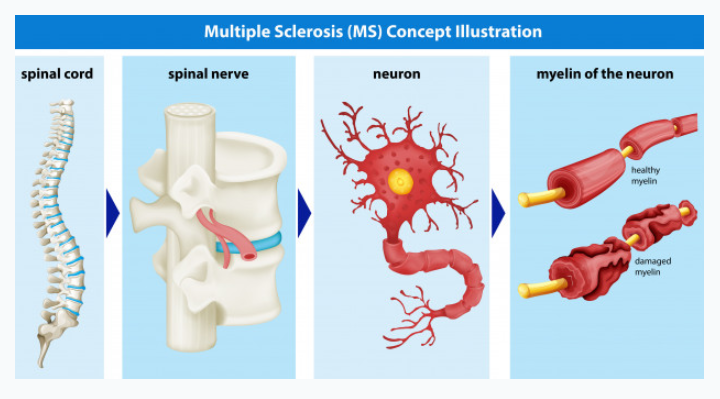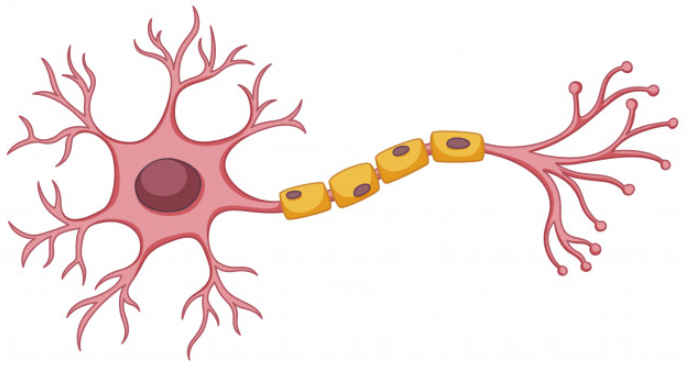Multiple Sclerosis & Physical Therapy
By: Dr. Abe Kopolovich, DPT, MBA

Physical therapy (PT) plays an important role in rehabilitation and conservation of functional abilities for a person with MS. Since MS affects individuals very differently, with disability progressing over time, the physical therapist is challenged to tailor a unique treatment plan for each person and adjust that plan as needed over the long term. Additionally, since MS affects various aspects of a person’s life and requires a unified team approach for successful management, the PT must be comfortable working with members of the care team, including other rehabilitation specialists as well as the individual patient’s caregivers (family and friends).
CHALLENGES POSED BY MS
MS presents a variety of challenges due to the complex nature of the disease and wide range and combination of symptoms that may affect an individual. For instance, it is common for a person with MS to experience fatigue and weakness caused by physical or neurological deficits. However, these symptoms may be associated with an elevated core body temperature (from infection or overexertion), side effects of medications used to treat pain or spasticity, obesity from physical inactivity, sleep problems (complicated by bladder dysfunction, pain, or spasticity), stress, depression and other mood disorders, and medical conditions such as anemia. A range of invisible neurologic symptoms, including vision, sensory, and cognitive problems, sexual dysfunction, and bladder and bowel problems may make physical therapy interventions difficult.
ROLE OF PHYSICAL THERAPY
The role of physical therapy in MS changes as the patient’s needs change, due to relapse, disability progression, or disease course. However, the goals of physical therapy will remain the same, to help you achieve and maintain physical functioning, safety, quality of life, and independence. To achieve these goals, your PT will use tools that include education and instruction, emotional support and encouragement, and appropriate equipment and assistive technologies. The specific interventions that your PT uses will depend on your symptoms and disease course, but a successful physical therapy program for a person with MS will:

- Educate you and your caregivers (family and/or friends) about physical symptoms of MS and what you can do to alleviate these symptoms
- Develop an individualized exercise program to address symptoms and maximize health and function
- Introduce aids and adaptive equipment for home, office, and automobile to enhance mobility and functionality
- Design physical therapy interventions to address specific impairments
- Identify community resources that support goals of physical therapy
Physical Therapy Goals and Interventions Vary According to Disease Course
Time of diagnosis:
- Baseline evaluation of physical functioning should be performed
- Education concerning disease and its management, including appropriate exercises and activities, how to deal with fatigue, and addressing subtle impairments in gait or balance
- Support and encouragement
Following exacerbation:
- Goal of return to baseline functioning
- Often a wait of 2 weeks is recommended before physical therapy because of weakness, side effects from medications, and other factors
Progressive disease:
- Physical therapy should be used proactively due to the steady decline in functioning
- Goals include support, resourcing (assistive tech), preventing de-conditioning, safety, and maximizing health and functioning
Advanced disease:
- Since person is typically non-ambulatory, physical therapy will focus on seated trunk positioning and control, transfers, strength in upper extremity, breathing, and assistive tech needs
- Standing devices are useful in allowing stretching to ease spasticity, bowel and bladder relief, weight on long bones, and improved breathing and speech projection
Physical therapy assessment
Your PT will make an initial assessment at your first meeting. He or she will take a thorough medical history, asking you about what symptoms affect you the most, the medications you take, other medical conditions you have, and the top three problems that most affect your quality of life. This initial assessment will establish a good baseline (where you’re starting from) by which to measure progress during therapy. Tools that your PT may use to evaluate your physical functioning include a walking test (how quickly you can walk 25 feet or how far you can walk in 2 or 6 minutes), a standardized disability assessment called the Expanded Disability Status Scale (EDSS), tests of your ability to feel sensations including heat, cold, pain, and pressure, and assessments of balance, gait, physical exertion, and joint/muscle flexibility. An important goal of the assessment is to find out how well you function in the range of areas shown in the table below.
.
Physical Therapy Assessment of Functioning
Posture, trunk control, balance, and transfers:
- Seated and standing posture
- Static and dynamic balance
- Ability to transfer from bed, chair, toilet, car, and floor (as appropriate)
Ambulation and mobility:
- Consider factors including vision, sensation, deficits in balance, spasticity, weakness, shoe wear
- Goal of normalizing gait pattern (for ambulatory individuals)
- Assess need for ambulatory aids
Range of motion
Assess for extremities (legs and arms) and trunk
Motor function
Focus on strength in extremities (legs and arms) and trunk, with emphasis on function
Neurologic function
Check for problems including abnormal tone, clonus, tremors, sensory deficits, and pain
Respiratory function
Assess for breathing capacity
Wheeled mobility
Assess for need for wheelchair or scooter
Range of motion
Assess for extremities (legs and arms) and trunk
Physical therapy treatment plan
After a thorough assessment, your physical therapist will begin to work with you to put together a treatment plan which will typically include a home exercise program tailored to your specific symptoms and challenges. Often this will include corrective exercises to improve alignment, mobility, and strength. If you experience spasticity, the program may include slow stretching, use of cold packs, and controlled position changes. If you experience fatigue, your plan may focus on energy management, including careful pacing, flexible schedules for work and activity, and avoidance of overexertion.


